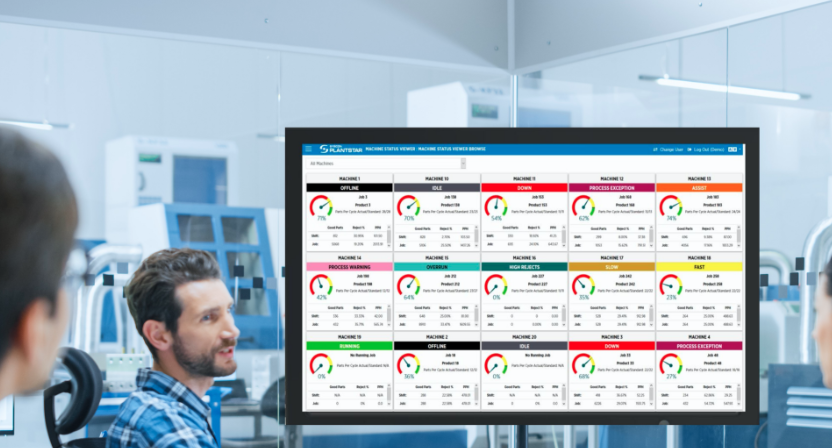PlantStar BLOG
Custom MES Reports Provide Manufacturers Actionable Insights
Jun 2, 2023 4:30:00 PM / by PlantStar Team

Manufacturers have more information at their disposal than ever before. However, simply collecting data is not enough; it’s the ability to turn that data into actionable insights that empowers manufacturers. A manufacturing execution system (MES) provides powerful data collection and analysis, allowing manufacturers to streamline operations, optimize workflow, increase efficiency, and create stronger businesses.
Manufacturing organizations collect data from various sources, such as the supply chain, manufacturing floor, and back office. The information spans a growing range of areas, including customer names, orders, location, and payment histories. They also track the movement of materials through the supply chain, monitoring their status, progress, and delivery.
Recently, manufacturers have begun collecting information about manufacturing floor equipment. Deploying sensors to monitor manufacturing equipment enables suppliers to examine more than 100 metrics and evaluate items like stamping, bottling, labeling, packaging, molding, assembly, forming, printing, and device temperature. Because data by itself is of little to no value, however, effective data management is essential.
The first step is to consolidate information sources. Sitting at the central point of the different interactions, an MES becomes the place to do this. MES dashboards enable personnel to compare and contrast different data points, gauge trends, identify problems and opportunities, and make adjustments as needed. Here are a few key ways manufacturers can take advantage of the robust reporting functions of an MES.
Take a Deep Dive into Data
One problem with collecting a lot of information is the difficulty of correlating it. Fortunately, as the amount of data businesses collect has increased, so have the capabilities of analysis tools. Advanced analytics can support autonomous or semiautonomous data examinations. Autonomous data analysis relies on artificial intelligence algorithms to sift through large volumes of data, identify key points, and generate reports. A semiautonomous process supplements AI with human judgment. In both cases, the resulting analytics provide the context needed to illuminate manufacturing trends.
Create Key Performance Indicators
Because every business is unique, each has its own set of key performance indicators (KPIs). A manufacturer that focuses on delivering long lasting goods, for example, may set up reports to illustrate product quality, defects, and recalls, while one that emphasizes low costs may look at the number of items produced in a set time period and try to increase throughput. To best take advantage of MES reporting features, a business needs to understand its market position and workflow and then establish a set of KPIs that illustrate how well they are faring in their differentiating areas. The KPIs become the company’s most important metrics, so those reports are examined on a regular basis, often daily.
Gain Real-Time Insights
In the past, manufacturing was a reactionary process. Staff examined how well manufacturing processes went after they were completed. Consequently, it was impossible to institute beneficial changes as events—such as a delay in material delivery—occurred. New MES solutions provide real-time performance information. As a result, managers can see how well manufacturing flows are performing while they’re in progress. In addition, the system highlights KPIs, generating alerts that inform staff when aberrations occur so they can quickly take appropriate action.
Gauge Equipment Efficiency
Manufacturers want to keep close tabs on equipment performance. An overall equipment efficiency (OEE) report illustrates measurements like actual vs. planned downtime, actual vs. standard production rates, and number of defects. Report customization features allow plant management to evaluate key elements in the process to meet specific objectives. Combined with preventive maintenance, OEE reports allow manufacturers to see issues before they cause problems and take proactive steps rather than reacting when equipment fails.
Evaluate Process and Production Monitoring
Machine monitoring and production monitoring are two important tools for manufacturers seeking to optimize operations. Machine monitoring provides insight into how well the shop floor equipment is running, enabling personnel to respond to potential problems and mitigate their impact. Metrics like cycle time and temperature, for example, can indicate when a system may be wearing down and in need of a maintenance checkup. Process monitoring measures manufacturing variables so employees can gauge how well the system is functioning. Statistical process control (SPC), a method of quality control that statistically evaluates process performance, can track process variables and create real-time, actionable reports.
Manufacturers have a lot of information at their disposal nowadays. A robust MES solution like PlantStar's provides reports that help manufacturers dig into the information, see connections and context, and make changes that improve processes and boost their bottom line. To see how the PlantStar MES is already benefitting manufacturers like you, view our case studies.
Topics: MES 101, mes software
Subscribe to Email Updates
Posts by Topic
- Manufacturing Execution Systems (38)
- manufacturing solutions (16)
- MES 101 (13)
- Industry 4.0 (11)
- improve efficiency (10)
- Plastic Molding (9)
- Plastics Technology (9)
- mes software (9)
- mes solutions (9)
- MES hardware (8)
- Shop Floor Production (8)
- digital transformation (7)
- Reduce scrap (6)
- data-driven-decisions (6)
- Medical molding (5)
- lean manufacturing (5)
- process monitoring (5)
- product quality (5)
- lights-out manufacturing (4)
- manufacturing dashboard (4)
- production monitoring (4)
- ERP integration (3)
- Shop Floor Safety (3)
- supply chain management (3)
- Injection Molding Technology (2)
- defect collection (2)
- machine mes (2)
- process variables (2)
- digital strategy (1)
- labor gap (1)
- throughput (1)
Related Articles


